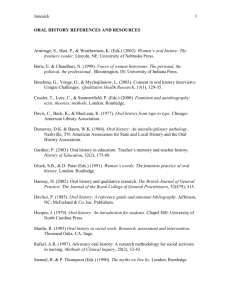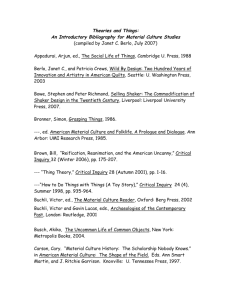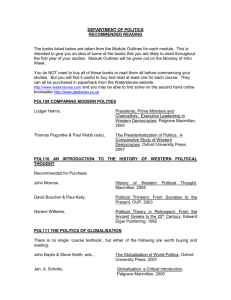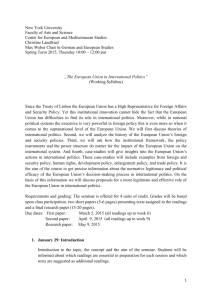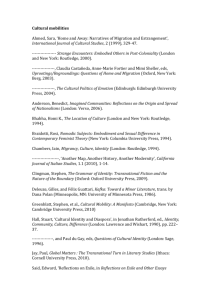Course Outline - e
advertisement
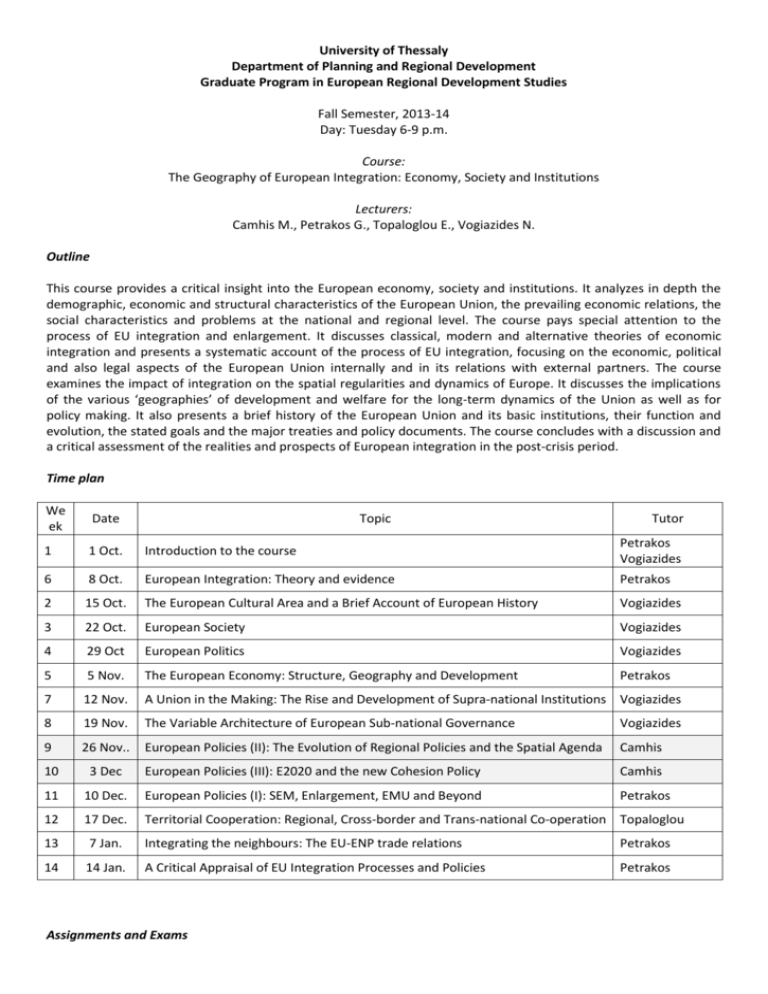
University of Thessaly Department of Planning and Regional Development Graduate Program in European Regional Development Studies Fall Semester, 2013-14 Day: Tuesday 6-9 p.m. Course: The Geography of European Integration: Economy, Society and Institutions Lecturers: Camhis M., Petrakos G., Topaloglou E., Vogiazides N. Outline This course provides a critical insight into the European economy, society and institutions. It analyzes in depth the demographic, economic and structural characteristics of the European Union, the prevailing economic relations, the social characteristics and problems at the national and regional level. The course pays special attention to the process of EU integration and enlargement. It discusses classical, modern and alternative theories of economic integration and presents a systematic account of the process of EU integration, focusing on the economic, political and also legal aspects of the European Union internally and in its relations with external partners. The course examines the impact of integration on the spatial regularities and dynamics of Europe. It discusses the implications of the various ‘geographies’ of development and welfare for the long-term dynamics of the Union as well as for policy making. It also presents a brief history of the European Union and its basic institutions, their function and evolution, the stated goals and the major treaties and policy documents. The course concludes with a discussion and a critical assessment of the realities and prospects of European integration in the post-crisis period. Time plan We ek Date 1 1 Oct. Introduction to the course Petrakos Vogiazides 6 8 Oct. European Integration: Theory and evidence Petrakos 2 15 Oct. The European Cultural Area and a Brief Account of European History Vogiazides 3 22 Oct. European Society Vogiazides 4 29 Oct European Politics Vogiazides 5 5 Nov. The European Economy: Structure, Geography and Development Petrakos 7 12 Nov. A Union in the Making: The Rise and Development of Supra-national Institutions Vogiazides 8 19 Nov. The Variable Architecture of European Sub-national Governance Vogiazides 9 26 Nov.. European Policies (II): The Evolution of Regional Policies and the Spatial Agenda Camhis 10 3 Dec European Policies (III): E2020 and the new Cohesion Policy Camhis 11 10 Dec. European Policies (Ι): SEM, Enlargement, EMU and Beyond Petrakos 12 17 Dec. Territorial Cooperation: Regional, Cross-border and Trans-national Co-operation Topaloglou 13 7 Jan. Integrating the neighbours: The EU-ENP trade relations Petrakos 14 14 Jan. A Critical Appraisal of EU Integration Processes and Policies Petrakos Topic Assignments and Exams Tutor Student performance evaluation will be based on two take-home assignments (30% of final grade each) and a final exam (40% of final grade). Main Bibliography Baldwin, R. and Wyplosz, C. (2006) ‘The Economics of European Integration’, McGraw Hill Cole, J. and Cole, F. (1997) ‘A geography of the European Union’, Second Edition, Routledge. Davies, N., (1997) Europe: A History, Pimlico Hudson, R. and Williams, A. (1999) ‘Divided Europe: Society and Territory’, Sage. Molle, W. (2006) The economics of European Integration: Theory, Practice and Institutions, Ashgate. Nagle, G. and Spencer, K. (1996) ‘A Geography of the European Union: A Regional and Economic Perspective’ Oxford University Press. Petrakos G., Maier G. and Gorzelak G. (eds.) (2000) ‘Integration and Transition in Europe: The economic Geography of Interaction’, Routledge. Rodriguez-Pose, A. (2002) ‘The European Union: Economy, Society and Polity’, Oxford. Καμχής, Μ. (2007) ‘Η Ενοποίηση του Ευρωπαϊκού Χώρου 1986-2006’ Κριτική. Lecture outline and reading list 1. The European Economy: structure, geography and development This lecture focuses on the basic characteristics of the European economy, its evolution and structural change and its internal relations and inequalities. It also examines patterns of specialization, trade and capital mobility among EU countries and analyzes differences in development levels between countries and regions. Readings Rodriguez-Pose, A. (2002) The European Union: economy, society and polity. New York: Oxford University Press. Artis, M. and Nixson, F. (2007) The economics of the European Union, policy and analysis, Oxford University Press (4th edition). Amiti, M. (1998) “New trade theories and industrial location in the EU: a survey of evidence”, Oxford Review of Economic Policy, vol.14, No 2. Amiti, M. (1999) “Specialization patterns in Europe”, Weltwirtschaftliches Archiv, vol 135, pp. 1-21. Combes, P. and Overman, H. (2003) “The spatial distribution of economic activities in the European Union”, Urban and Regional Economics, vol. 4 (Henderson and Thisse eds). Dunford, M. (1994) “Winners and Losers: The New Map of Economic Inequality in the European Union”, European Urban and Regional Studies. Vol 1, No2, pp. 95-114. Midelfart-Knarvik, K., Overnman, H. and Venables, A. (2000) “Comparative advantage and economic geography: estimating the location of production in the EU”, discussion paper, No 2618, CEPR. Molle, W. (2006) The economics of European integration: theory, practice, policy. Aldershot: Ashgate. Petrakos G., Maier G. and Gorzelak G. (2000) (eds) Integration and Transition in Europe: The Economic Geography of Interaction. London: Routledge. 2. The European cultural area and a brief account of European history Well before it developed common institutions and governance structures, Europe represented a distinct, albeit complex, cultural community. Variety, rifts and competition characterized its cultural development, struggles for cultural dominance both reflecting and feeding back onto the broader socio-economic sphere. Yet, ever since the medieval era, the contours of a European cultural domain were becoming visible, encompassing in the course of time major pointers, such as the allegiance to a Christian creed, the development of ethnic and, later, national collective identities, the assumption, through the Renaissance and Enlightenment, of both some opaque common origin and, more importantly, a shared humanistic universalist prospect. The deep ruptures and totalizing conflicts of the twentieth century added as much to cultural complexity as to the quest for convergence. The lecture will attempt an inevitably selective historical tour of the European cultural area. Readings Davies, N., (2007)Europe East and West, Pimlico, chapters 1-3 (pp. 5-60) Davies, N., (1997) Europe: A History, Pimlico Duroselle, J.-B., Europe: A History of its People, Viking (London, 1990) Hobsbawm, E.J., (2000 [1962]) The Age of Revolution: Europe 1789-1848, Weidenfeld and Nicolson Hobsbawm, E.J., (2000 [1975]) The Age of Capital, 1848-1875, Weidenfeld and Nicolson Hobsbawm, E.J., (2000 [1987]) The Age of Empire, 1975-1914, Weidenfeld and Nicolson Hobsbawm, E.J., (1994) Age of Extremes: The Short Twentieth Century, 1914-1991, Michael Joseph / Penguin Group Mazower, M. (1998) Dark Continent: Europe’s Twentieth Century, Allen Lane 3. European Society Is there such thing as a European society above and beyond the patchwork of the different societal forms to be found at national and regional level in contemporary Europe? What might be its defining traits, or, in Weberian terms, its ideal type characteristics that might distinguish it from and enable comparisons with other types of society? To what extent are certain aspects of industrial and economic organization prevalent across Europe reflected in a convergence of societal forms? Are the welfare state, consensual industrial relations, or the mixed economy specifically, or primarily, European attributes, and do they imply some concomitant shared societal characteristics? Such are the issues at stake regarding the prospects of social integration at European level. Readings Outhwaite, W. (2008), European Society, Cambridge, Polity, chapters 1, 2 and 5 Therborn, G. (1994), European Modernity and Beyond: The Trajectory of European Societies, 1945-2000, London, Sage Crouch, C. (1999), Social Change in Western Europe, Oxford University Press Nielsen, R. and Szyszcak, E. M. (1997), The Social Dimension of the European Union, Copenhagen, Handelshojskolens Forlag 4. European Politics This lecture will attempt to define the lineaments of a European politics that has transcended nation states, preceded the integrative project of the European Communities/Union, spurned its emergence and development and, indeed up to this day, ensured the general directional imperatives of a supra-national European polity. The transition from local community to nation state in the eighteenth and nineteenth centuries, the latter’s dominance in the late nineteenth and early twentieth centuries, the deep crisis it faced in the historical troughs of two world wars, Europe’s post-war rupture into two conflictual socio-political blocks and, finally, the centripetal shift towards shared sovereignty across most of the European continent, deeply affected every European state. As did the transition from the liberal ‘watchman’ state of the nineteenth century to the social-democratic welfare state of the twentieth and the ensuing neo-liberal backlash of recent decades in the name of a monetary orthodoxy and fiscal probity. Readings Davies, N., Europe: A History, Pimlico (London, 1997) Hay, C. and Menon, A., European Politics, Oxford University Press (Oxford, 2007) Gallagher, M. et al, Representative Government in Modern Europe, McGraw-Hill (Maidenhead, 2011) Heywood, P. et al (eds) (2006), Developments in European Politics, Basingstoke, Palgrave Wilson, F. L. et al, (1999), European Politics Today, London, Pearson Books Hogwood, P. and Roberts, G. K. (2003), European Politics Today, Manchester University Press Lane, J.-E. and Ersson, S. O. (1999), Politics and Society in Western Europe, London, Sage Colomer, J. M. (ed.)(2008), Comparative European Politics, Abingdon, Routledge Steiner, J. and Crepaz, M. (2007), European Democracies, Harlow, Longman Slomp. H. (2000),European Politics into the Twenty-First Century: Integration and Division, Westport CT, Praeger Giddens, A. et al (eds) (2006), Global Europe, Social Europe, Cambridge, Polity 5. Theories of economic integration The process of economic integration is primarily related to the removal of all obstacles and barriers to the free movement of goods, services, labor and capital between countries, on the expectation that this win-win policy will have positive effects to all parties involved. This lecture provides a brief account and a discussion of the theories of economic integration, presenting both the neoclassical approach and more recent alternative theories and frameworks of analysis. Readings 6 Wiener A. and Diehl T. (2003) Theories of European Integration: Past, Present and Future, Oxford: Oxford University Press. Bradley J., Petrakos G. and Traistaru J. (2004) (eds.) Integration, Growth and Cohesion in an Enlarged European Union, Springer. Krieger-Boden C., Morgenroth E. and Petrakos G. (2008) (eds) The Impact of European Integration on Regional Structural Change and Cohesion, London: Routledge. Helmpan, E. and Krugman, P. (1985) Market Structure and Foreign Trade: increasing returns, Imperfect Competition, and the International Economy, The MIT Press, Cambridge, Massachusetts. Krugman, P. and Venables, A. (1995) “Globalization and the Inequality of Nations”, Quarterly Journal of Economics CX: 857-80. Rosamond, B. (2000) Theories of European integration. New York: Palgrave. Brülhart, M. (1998a) “Economic geography, industry location and trade: the evidence”, World Economy, vol. 21. Brülhart, M. (2006) “European integration post-enlargment: a new economic geography approach”, policy seminar, UNIL, Brussels. Krugman, P. (1979) “Increasing returns, monopolistic competition and international trade”, Journal of International Economics, vol. 9, pp. 469-479. Krugman, P. (1989) “Increasing returns and economic geography”, Journal of Political Economy, vol 99, pp.48399. Petrakos G. (2003) ‘Peripheral European Transitions: The Trade Relations of the Balkan Countries’ South-Eastern Europe Journal of Economics, 1(1): 41-64. Petrakos, G. Fotopoulos, G. and Kallioras, D. (2012) ‘Peripherality and Integration: Industrial Growth and Decline in the Greek Regions’, Environment and Planning C, 30(2), pp.347-361. European Policies: SEM, Enlargement, EMU and Beyond This lecture will provide an account of the economic and spatial characteristics of the creation of the Single European Market (SEM), the EU enlargement process and the establishment of the Economic and Monetary Union (EMU), including an ex-post evaluation of market processes and policy decision. A discussion will take place about the impact of integration, transition and enlargement on East-West patterns of trade, on labour and capital flows, on economic and industrial structures, location decision patterns and changes with respect to levels of development. Readings: Weiler, H., Begg, I. and Peterson, J. (2003) Integration in an Expanding Union, Blackwell. Andersen, S. and Eliassen, K. (2001) Making Policy in Europe, London: Sage, 2nd edition. Gillingham, J. (2003) European Integration 1950-2003. Superstate or New Market Economy? Cambridge University Press. 7. Morgenroth E. and Petrakos G. (2008), Structural Change and Regional Policy: Concluding remarks in KriegerBoden C., Morgenroth E. and Petrakos G. (eds), The Impact of Economic Integration on Regional Structural Change and Cohesion, London: Routledge, pp. 285-304. Petrakos G. and Kallioras D. (2007), Integration and Structural Change: Pre-Acession Experience in the Regions of the European Union New Member-States in Getimis P. and Kafkalas G. (eds): Overcoming Fragmentation in Southeast Europe: Spatial Development Trends and Integration Potential, Aldershot: Ashgate, pp 39-73. Petrakos G. and Economou D. (2004) ‘Spatial Asymmetries in Southeastern Europe’, Journal of Economic Asymmetries, 1(1): 127-149. Petrakos G. (2002) ‘The Balkans in the New European Economic Space: Prospects of Adjustment and Policies of Development’, Eastern European Economics, 40(4):6-30. Kotios A. and Petrakos G. (2002) (eds.) Restructuring and Development in Southeastern Europe, Volos: SEED University of Thessaly Press. Petrakos G. and Totev S. (2001) (eds.) "The Development of the Balkan Region", Aldershot: Ashgate. Richardson, J. (2006) European Union, power and policy-making, Routledge (3nd edition). Peterson, J. and Shackleton, M. (2002) The Institutions of the European Union, Oxford: Oxford University Press. Pierson P. (1996) The Path to European Integration: A Historical Institutionalist Analysis Comparative Political Studies, Vol. 29, No. 2, pp. 123-163 James, S. and Gough, J. (2004) “The economic and politics of Economic Monetary Union (EMU) in Morland D. and Cowling, M. (2004) Political issues for the twenty-first century (chapter 8), Ashgate. Kraft, R. (2006) The creation of the European Monetary Union, GRIN. Krugman, P. (1993) “Lessons of Massachusetts for EMU”, in Torres, F. and Giavazzi, F. (eds) Adjustment and Growth in the European Monetary Union. London: CEPR and Cambridge University Press. Preston, C. (1997) Enlargement and integration in the European Union, Routledge. Grabbe, H. (2003) “Europeanization goes east: power and uncertainty in the EU accession process” in K. Featherstone and Radaelli, C. (2003) The politics of Europeanization, Oxford University Press. Bieler, A. (2002) “The struggle over EU enlargement: a historical materialist analysis of European integration”, Journal of European Public Policy, vol 9, pp. 575-597. Breuss, F. (2001) “Macroeconomic effects of EU enlargement for old and new members”, WIFO-Monatsberichte, 74(11), pp.655-666. Bresuss, F. (2004) “Benefits and dangers of EU enlargement”, Empirica, 29(3), pp.245-274. Smith, K. (2005) “The outsiders: the neighborhood policy”, International Affairs, 81(4), pp.757-773. Kallioras, D. and Petrakos, G. (2010) “Industrial growth, economic integration and structural change: evidence from the EU new member-states”, Annals of Regional Science, 45(3), pp. 667-680. Petrakos G., Maier G. and Gorzelak G. (2000) (eds.) "Integration and Transition in Europe: The Economic Geography of Interaction", London: Routledge. Petrakos G. (2000) 'The spatial impact of East-West integration in Europe', in Petrakos, Maier and Gorzelak (eds.) Integration and Transition in Europe: The Economic Geography of Interaction, London: Routledge, 38-68. Petrakos G. and Christodoulakis N. (2000) “Greece and the Balkans: The challenge of integration”, in Petrakos, Maier and Gorzelak (eds.) Integration and Transition in Europe: The Economic Geography of Interaction, London: Routledge, 269-294. Petrakos G. (2001) ‘Fragmentation and conflict or integration and cooperation in the Balkans? Strategies of development for the 21st century’, in Petrakos and Totev (eds.) The Development of the Balkan Region, Aldershot: Ashgate, 219-234. Petrakos G., Mayer G. and Gorzelak G. (2000) ‘The New Economic Geography of Europe’, in Petrakos, Maier and Gorzelak (eds.) Integration and Transition in Europe: The Economic Geography of Interaction, London: Routledge, 1-37. A Union in the Making: The Rise and Development of Supra-national Institutions The emergence and development of supra-national European institutions. The European Union as a unique institutional construct, decision-making process and ‘nationless’ state. The rough road from Paris and Rome to Lisbon and beyond via Luxemburg, Maastricht, Amsterdam and Nice. Readings: An overview of the history of the EU and of the structure and functioning of the European Institutions is presented at the official EU site http://europa.eu/index_en.htm. This site provides also useful and detailed information on all EU policies. The European Commission's booklet "Europe in 12 lessons" by Pascal Fontaine can be downloaded in text only or illustrated version from http://ec.europa.eu/publications/booklets/eu_glance/60/index_en.htm How the European Union works. Your guide to the EU institutions, European Commission, Manuscript completed in July 2007, in http://ec.europa.eu/publications/booklets/eu_glance/68/index_en.htm Dinan, D., (2004), Europe Recast: A History of the European Union, Palgrave MacMillan Davies, N., (1997), Europe a History, chapter XII ‘Europe divided and undivided 1945-1991’ Craig, P., (2008) “The Treaty of Lisbon: Process, architecture and substance”, European Law Review, No 2, pp.137-166. Dougan, M. (2008) “The treaty of Lisbon 2007: winning minds, not hearts”, Common Market Law Review 45: 617–703. Middelaar, L. van, (2013), The Passage to Europe: How a Continent Became a Union, Yale University Press 8. The Variable Architecture of European Sub-national Governance A variety of constitutional forms and political institutions characterizes the polity of European states. From constitutional monarchies to presidential republics, unitary states to federations (or confederations), the sovereignty of parliament to the recourse to referenda, single party governments to multi-party coalitions, the spread is significant. Awareness of the complexity of European politics is a prerequisite to an understanding of developments at national as well as European level. Yet, in the face of common challenges, a shared European polity is also emerging, extending below the institutions of the European Union and affecting the organization of national states. Its characteristics, efficacy and potential need to be further probed. Readings: 9. Heywood, P. et al (eds) (2006), Developments in European Politics, Basingstoke, Palgrave Wilson, F. L. et al, (1999), European Politics Today, London, Pearson Books Hogwood, P. and Roberts, G. K. (2003), European Politics Today, Manchester University Press Lane, J.-E. and Ersson, S. O. (1999), Politics and Society in Western Europe, London, Sage Colomer, J. M. (ed.)(2008), Comparative European Politics, Abingdon, Routledge Steiner, J. and Crepaz, M. (2007), European Democracies, Harlow, Longman Slomp. H. (2000),European Politics into the Twenty-First Century: Integration and Division, Westport CT, Praeger Giddens, A. et al (eds) (2006), Global Europe, Social Europe, Cambridge, Polity Stoker, G., (1991) The Politics of Local Government, Palgrave Macmillan Cockburn, C., (1977) The Local State: Management of Cities and People Pluto European Policies: The Evolution of Regional Policies and the Spatial Agenda The Lecture will examine the EU efforts of reducing economic and social disparities. Important financial resources have been set aside in the EU budget for the social and economic cohesion policy. As from 1989, the Union has been endowed with a European regional policy which considers the European territory as a whole, supporting regions and local areas which have been selected on the basis of purely European criteria. Less developed regions, regions of industrial decline and rural areas have benefited, over the years, from the EU's structural and cohesion funds. The current period 2007-2013 will be covered. A series of actions which have been elaborated in the framework of regional policy will be also examined during this lecture. Without being policies in themselves, in the strict sense of the term, they have as their primary objective the better organization of the European territory. The programmes of cross-border and trans-national cooperation in spatial/territorial planning will be covered. Internal and external border regions of the Union had up to the mid-80's very few opportunities of cooperation. The cross-border cooperation programmes have opened a totally new perspective to European integration. European Union actions for urban areas will be also examined. Readings: "Inforegio" the Regional Policy website provides practically all relevant information on how EU cohesion policy operates today, including issues of cross-border and transnational cooperation. http://ec.europa.eu/regional_policy/index_en.htm Dinan, D. and Camhis, M., (2004), "The Common Agricultural Policy and Cohesion" in Green-Cowles, M. and Dinan, D., (eds.), Developments in the European Union 2, New York, Palgrave. The Community Strategic Guidelines for 2007-2013 contain the principles and priorities of cohesion policy and suggest ways the European regions can take full advantage of the € 308 billion that has been made available for national and regional aid programmes. http://ec.europa.eu/regional_policy/sources/docoffic/2007/osc/index_en.htm Presentation of current programmes of cross-border, transnational and interregional co-operation in http://ec.europa.eu/regional_policy/cooperation/index_en.htm A presentation of actions for urban areas can be found in Promoting Sustainable Urban Development in Europe Achievements and Opportunities (April 2009 ) http://ec.europa.eu/regional_policy/sources/docgener/presenta/urban2009/urban2009_en.pdf Economou D., Kokkosis H. and Petrakos G. (2005) ‘The ESDP relevance to a distant partner: Greece’, European Planning Studies, 13(2): 253-264. 10. Territorial Cooperation: Regional, Cross-border and Trans-national Co-operation The processes of European Union (EU) integration and enlargement have produced a new regional socioeconomic map in Europe. Border regions, in particular, have been put in a state of flux. The re-allocation of activities, opportunities and threats is changing their socio-economic role and significance. Thus, border regions have become an issue of great importance during the last fifteen years in both the areas of scientific research and policy making. This lecture analyses border regions, interpreting the socioeconomic dynamics occurring within the enlarged EU space and provides a framework to assess the relative position of each EU border region in the EU space. Readings: Petrakos, G. and Topaloglou, E. (2008), ‘Economic geography and European integration: The effects on the EU’s external borders’, International Journal of Public Policy, 3(3-4): 146-162. Topaloglou, E., Kallioras, D., Manetos, P. and Petrakos, G. (2005), ‘Towards a border regions typology in the enlarged EU’, Journal of Borderland Studies, 20(2): 67-89. Τοπάλογλου, Λ. και Πετράκος, Γ. (2009), “Αναζητώντας τις παραμέτρους ενός θεωρητικού υποδείγματος για την οικονομική γεωγραφία των συνόρων”, Αειχώρος, 12: pp.34-56 Τοπάλογλου, Ε. και Πετράκος, Γ. (2007) ‘Η γεωγραφία στάσεων και αντιλήψεων στα εξωτερικά σύνορα της Ευρωπαικής Ένωσης, Γεωγραφίες 13: 125-144. Τοπάλογλου Ε. και Πετράκος Γ. (2008) «Σύνορα, Ολοκλήρωση και Ανάπτυξη», Εκδόσεις Κριτική. 11 Integrating the Neighbors: EU-ENP Trade relations The last enlargement brought the borders of the EU to a set of countries in the East with historically less intensive economic relations. These countries (Ukraine, Byelorussia, Armenia, etc) have been for decades part of the Soviet Union and are characterized by lower development levels and significant institutional and structural differences. At the same time, in the Southern and the East rim of the Mediterranean Sea the EU is faced with a ring of countries that are linked to individual EU countries through their colonial past. Both bordering areas in the EU South and the East have been gaining significance in the last period as they include emerging economies, energy suppliers, or simply a large neighboring market with over 250 million inhabitants that is crucial for the EU economy. This new situation raises a number of important questions about the economic relations of the EU with its neighboring areas in the East and the South and the prospects and effects of deeper economic integration. Panagiotis Liargovas (2012) “EU trade policies towards neighboring countries”, SEARCH Project, FP7 for Research and Technological Development, European Commission Dimitris Kallioras, George Petrakos, Maria Tsiapa (2013) “The geography of trade relations between the EU and the ENP countries: Empirical analysis and implications for theory and policy-making”, SEARCH Project, FP7 for Research and Technological Development, European Commission Ron Boschma, Gianluca Capone (2013) “Mind your step: The heterogeneous effect of relatedness on the diversification process in EU and ENP countries” SEARCH Project, FP7 for Research and Technological Development, European Commission Ageliki Anagnostou, Dimitris Kallioras, George Petrakos (2013) “Integrating the neighbors: A dynamic panel analysis of EU-ENP trade relations”, SEARCH Project, FP7 for Research and Technological Development, European Commission Andrea Ascani, Riccardo Crescenzi, Simona Iammarino (2013) “MNEs location decisions in EU neighboring countries and economic institutions” SEARCH Project, FP7 for Research and Technological Development, European Commission Vassilis Monastiriotis, Mireia Borrell (2013) “Origin of FDI and domestic productivity spillovers: Does European FDI have a “productivity advantage” in the ENP countries?” SEARCH Project, FP7 for Research and Technological Development, European Commission Daria Zvirgzde, Daniel Schiller, Javier Revilla Diez (2013) “Location choices of multinational companies in Ukraine” SEARCH Project, FP7 for Research and Technological Development, European Commission George Petrakos, Dimitris Kallioras, Maria Tsiapa (2013) “Regional inequalities in the European Neighborhood Countries: The effects of growth and integration”, SEARCH Project, FP7 for Research and Technological Development, European Commission 12. E2020 and the new Cohesion Policy This lecture will attempt to critically evaluate the current situation with respect to the achievements, missed opportunities, but also costs and benefits of the European integration process. The lecture will provide the basis for a discussion on the challenges the European Union is currently facing with its institutional reform, the policies and the compromises that are necessary in order for the European policy structures to provide a range of services and support to EU citizen and at the same time operate in an efficient and transparent way. The discussion will focus primarily on the Lisbon Treaty, its provisions and the difficulties related with its approval by member States. It will also focus on the revision of the Cohesion Policy and the risks and opportunities that are related with this initiative. Readings: Craig, P. (2008) “The Treaty of Lisbon: Process, architecture and substance”, European Law Review, No 2, pp.137166. Dougan, M. (2008) “The treaty of Lisbon 2007: winning minds, not hearts”, Common Market Law Review 45: 617–703. Faludi, A. (2004) “Territorial Cohesion Policy and the European Model of Society”, Urban Studies, 41(7), pp. 1349-1365. Faludi, A. (2006) “From European spatial development to territorial cohesion policy”, Regional Studies, 40(6), pp.667-678. Griller, S. and Ziller, J. (2008) The Lisbon Treaty. Springer. Gros, D. and Kurpas, S. (2008) “What Next? How to Save the Treaty of Lisbon”, working paper, No 163, CEPS. Your guide to the Lisbon Treaty, European Commission, manuscript completed in July 2009, Catalogue number: NA-78-09-931-EN-C http://ec.europa.eu/publications/booklets/others/84/index_en.htm Barca (2009) “An Agenda for a Reformed Cohesion Policy: A place-based approach to meeting European Union challenges and expectations”, Directory General for Regional Policy, European Commission. http://ec.europa.eu/regional_policy/policy/future/barca_en.htm Polish Presidency (2011) “Territorial Dimensions of Development Policies, Post-Seminar Publication, Ostroda, 1819 July 2011. 13 A Critical Appraisal of EU Integration Processes and Policies The Lecture will attempt to describe options for the future development of the EU. Elements which will impact on the form and structure of the European territory include the definition of the geographical limits of the Union, its absorptive capacity and the different models for the organization and functioning of its Institutions. The European Union will also be transformed by the way in which it will tackle the major socioeconomic and political challenges in a rapidly changing global environment. Readings: Leonard, M., (2006), 21ος: ο αιώνας της Ευρώπης, Αθήνα: Κριτική (also in English Leonard, M., (2006), Why Europe Will Run the 21st Century) Economou D., Kokkosis H. and Petrakos G. (2005) ‘The ESDP relevance to a distant partner: Greece’, European Planning Studies, 13(2): 253-264. Petrakos, G. (2012) “Integration, spatial dynamics and regional policy dilemmas in the European Union”, Region and Periphery, 2. Morgenroth E. and Petrakos G. (2008), Structural Change and Regional Policy: Concluding remarks in KriegerBoden C., Morgenroth E. and Petrakos G. (eds), The Impact of Economic Integration on Regional Structural Change and Cohesion, London: Routledge, pp. 285-304.

